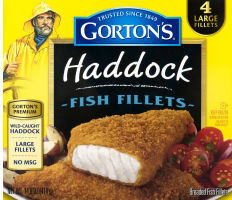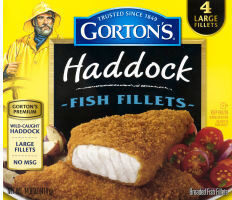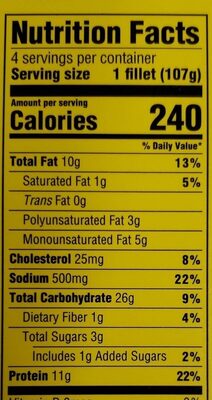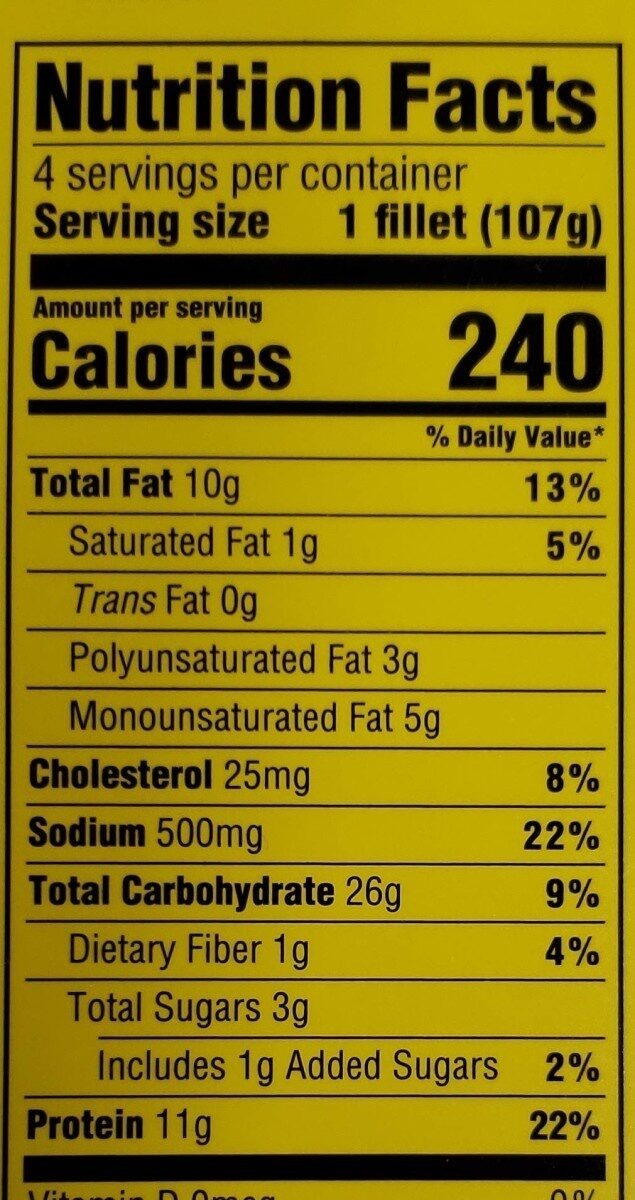Help us make food transparency the norm!
As a non-profit organization, we depend on your donations to continue informing consumers around the world about what they eat.
The food revolution starts with you!
Breaded Haddock Fish Fillets - Gorton's
Breaded Haddock Fish Fillets - Gorton's
This product page is not complete. You can help to complete it by editing it and adding more data from the photos we have, or by taking more photos using the app for Android or iPhone/iPad. Thank you!
×
Barcode: 0044400138208 (EAN / EAN-13) 044400138208 (UPC / UPC-A)
Brands: Gorton's
Brand owner: Gorton's of Gloucester
Categories: Seafood, Frozen foods, Frozen seafood
Countries where sold: United States
Matching with your preferences
Health
Ingredients
-
38 ingredients
Haddock, enriched bleached wheat flour (flour, niacin, iron, thiamin mononitrate, riboflavin, folic acid), vegetable oil (cottonseed and/or canola), water, less than 2% of: yellow corn flour, modified corn starch, salt, sugar, whey, wheat flour, baking powder (baking soda, sodium aluminum phosphate), yeast, lemon juice solids, maltodextrin, dextrose, caramel color, citric acid, colored with paprika, annatto, and turmeric extracts, natural flavor, dehydrated garlic, modified cellulose, malic acid, spices, sodium tripolyphosphate (to retain fish moisture).Allergens: Fish, Gluten, Milk
Food processing
-
Ultra processed foods
Elements that indicate the product is in the 4 - Ultra processed food and drink products group:
- Additive: E100 - Curcumin
- Additive: E150c - Ammonia caramel
- Additive: E160b - Annatto
- Additive: E452 - Polyphosphates
- Additive: E460 - Cellulose
- Ingredient: Dextrose
- Ingredient: Flavouring
- Ingredient: Glucose
- Ingredient: Maltodextrin
- Ingredient: Whey
Food products are classified into 4 groups according to their degree of processing:
- Unprocessed or minimally processed foods
- Processed culinary ingredients
- Processed foods
- Ultra processed foods
The determination of the group is based on the category of the product and on the ingredients it contains.
Additives
-
E296 - Malic acid
Malic acid: Malic acid is an organic compound with the molecular formula C4H6O5. It is a dicarboxylic acid that is made by all living organisms, contributes to the pleasantly sour taste of fruits, and is used as a food additive. Malic acid has two stereoisomeric forms -L- and D-enantiomers-, though only the L-isomer exists naturally. The salts and esters of malic acid are known as malates. The malate anion is an intermediate in the citric acid cycle.Source: Wikipedia
-
E330 - Citric acid
Citric acid is a natural organic acid found in citrus fruits such as lemons, oranges, and limes.
It is widely used in the food industry as a flavor enhancer, acidulant, and preservative due to its tart and refreshing taste.
Citric acid is safe for consumption when used in moderation and is considered a generally recognized as safe (GRAS) food additive by regulatory agencies worldwide.
-
E460 - Cellulose
Cellulose: Cellulose is an organic compound with the formula -C6H10O5-n, a polysaccharide consisting of a linear chain of several hundred to many thousands of β-1→4- linked D-glucose units. Cellulose is an important structural component of the primary cell wall of green plants, many forms of algae and the oomycetes. Some species of bacteria secrete it to form biofilms. Cellulose is the most abundant organic polymer on Earth. The cellulose content of cotton fiber is 90%, that of wood is 40–50%, and that of dried hemp is approximately 57%.Cellulose is mainly used to produce paperboard and paper. Smaller quantities are converted into a wide variety of derivative products such as cellophane and rayon. Conversion of cellulose from energy crops into biofuels such as cellulosic ethanol is under development as a renewable fuel source. Cellulose for industrial use is mainly obtained from wood pulp and cotton.Some animals, particularly ruminants and termites, can digest cellulose with the help of symbiotic micro-organisms that live in their guts, such as Trichonympha. In human nutrition, cellulose is a non-digestible constituent of insoluble dietary fiber, acting as a hydrophilic bulking agent for feces and potentially aiding in defecation.Source: Wikipedia
-
E500 - Sodium carbonates
Sodium carbonates (E500) are compounds commonly used in food preparation as leavening agents, helping baked goods rise by releasing carbon dioxide when they interact with acids.
Often found in baking soda, they regulate the pH of food, preventing it from becoming too acidic or too alkaline. In the culinary world, sodium carbonates can also enhance the texture and structure of foods, such as noodles, by modifying the gluten network.
Generally recognized as safe, sodium carbonates are non-toxic when consumed in typical amounts found in food.
-
E500ii - Sodium hydrogen carbonate
Sodium hydrogen carbonate, also known as E500ii, is a food additive commonly used as a leavening agent.
When added to recipes, it releases carbon dioxide gas upon exposure to heat or acids, causing dough to rise and resulting in a light, fluffy texture in baked goods.
It is generally recognized as safe (GRAS) by regulatory authorities when used in appropriate quantities and poses no significant health risks when consumed in typical food applications.
-
E541 - Sodium aluminium phosphate
Sodium aluminium phosphate: Sodium aluminium phosphate -SAlP- describes the inorganic compounds consisting of sodium salts of aluminium phosphates. The most common SAlP has the formulas NaH14Al3-PO4-8·4H2O and Na3H15Al2-PO4-8. These materials are prepared by combining alumina, phosphoric acid, and sodium hydroxide.In addition to the usual hydrate, an anhydrous SAlP is also known, Na3H15Al2-PO4-8 -CAS#10279-59-1-, referred to as 8:2:3, reflecting the ratio of phosphate to aluminium to sodium. Additionally an SAlP of ill-defined stoichiometry is used -NaxAly-PO4-z -CAS# 7785-88-8-.The acidic sodium aluminium phosphates are used as acids for baking powders for the chemical leavening of baked goods. Upon heating, SAlP combines with the baking soda to give carbon dioxide. Most of its action occurs at baking temperatures, rather than when the dough or batter is mixed at room temperature. SAlPs are advantageous because they impart a neutral flavor. As a food additive, it has the E number E541. Basic sodium aluminium phosphates are also known, e.g., Na15Al3-PO4-8. These species are useful in cheese making.Source: Wikipedia
Ingredients analysis
-
Palm oil free
No ingredients containing palm oil detected
Unrecognized ingredients: Less-than-2-of, Colored-with-paprika, And-turmeric-extracts, Modified-cellulose, To-retain-fish-moistureSome ingredients could not be recognized.
We need your help!
You can help us recognize more ingredients and better analyze the list of ingredients for this product and others:
- Edit this product page to correct spelling mistakes in the ingredients list, and/or to remove ingredients in other languages and sentences that are not related to the ingredients.
- Add new entries, synonyms or translations to our multilingual lists of ingredients, ingredient processing methods, and labels.
If you would like to help, join the #ingredients channel on our Slack discussion space and/or learn about ingredients analysis on our wiki. Thank you!
-
Non-vegan
Non-vegan ingredients: Haddock, WheySome ingredients could not be recognized.
We need your help!
You can help us recognize more ingredients and better analyze the list of ingredients for this product and others:
- Edit this product page to correct spelling mistakes in the ingredients list, and/or to remove ingredients in other languages and sentences that are not related to the ingredients.
- Add new entries, synonyms or translations to our multilingual lists of ingredients, ingredient processing methods, and labels.
If you would like to help, join the #ingredients channel on our Slack discussion space and/or learn about ingredients analysis on our wiki. Thank you!
-
Non-vegetarian
Non-vegetarian ingredients: HaddockSome ingredients could not be recognized.
We need your help!
You can help us recognize more ingredients and better analyze the list of ingredients for this product and others:
- Edit this product page to correct spelling mistakes in the ingredients list, and/or to remove ingredients in other languages and sentences that are not related to the ingredients.
- Add new entries, synonyms or translations to our multilingual lists of ingredients, ingredient processing methods, and labels.
If you would like to help, join the #ingredients channel on our Slack discussion space and/or learn about ingredients analysis on our wiki. Thank you!
-
Details of the analysis of the ingredients
We need your help!
Some ingredients could not be recognized.
We need your help!
You can help us recognize more ingredients and better analyze the list of ingredients for this product and others:
- Edit this product page to correct spelling mistakes in the ingredients list, and/or to remove ingredients in other languages and sentences that are not related to the ingredients.
- Add new entries, synonyms or translations to our multilingual lists of ingredients, ingredient processing methods, and labels.
If you would like to help, join the #ingredients channel on our Slack discussion space and/or learn about ingredients analysis on our wiki. Thank you!
: Haddock, wheat flour (flour, niacin, iron, thiamin mononitrate, riboflavin, folic acid), vegetable oil (cottonseed, canola), water, less than 2% of (yellow corn flour), modified corn starch, salt, sugar, whey, wheat flour, baking powder (baking soda, sodium aluminum phosphate), yeast, lemon, maltodextrin, dextrose, caramel color, citric acid, colored with paprika, annatto, and turmeric extracts, natural flavor, garlic, modified cellulose, malic acid, spices, sodium tripolyphosphate (to retain fish moisture)- Haddock -> en:haddock - vegan: no - vegetarian: no - ciqual_food_code: 26122 - percent_min: 3.84615384615385 - percent_max: 100
- wheat flour -> en:wheat-flour - vegan: yes - vegetarian: yes - ciqual_proxy_food_code: 9410 - percent_min: 0 - percent_max: 50
- flour -> en:flour - vegan: yes - vegetarian: yes - ciqual_proxy_food_code: 9410 - percent_min: 0 - percent_max: 50
- niacin -> en:e375 - vegan: maybe - vegetarian: maybe - percent_min: 0 - percent_max: 25
- iron -> en:iron - percent_min: 0 - percent_max: 16.6666666666667
- thiamin mononitrate -> en:thiamin-mononitrate - percent_min: 0 - percent_max: 12.5
- riboflavin -> en:e101 - vegan: maybe - vegetarian: yes - percent_min: 0 - percent_max: 10
- folic acid -> en:folic-acid - percent_min: 0 - percent_max: 8.33333333333333
- vegetable oil -> en:vegetable-oil - vegan: yes - vegetarian: yes - from_palm_oil: maybe - percent_min: 0 - percent_max: 33.3333333333333
- cottonseed -> en:cottonseed - vegan: yes - vegetarian: yes - percent_min: 0 - percent_max: 33.3333333333333
- canola -> en:canola - vegan: yes - vegetarian: yes - percent_min: 0 - percent_max: 16.6666666666667
- water -> en:water - vegan: yes - vegetarian: yes - ciqual_food_code: 18066 - percent_min: 0 - percent_max: 25
- less than 2% of -> en:less-than-2-of - percent_min: 0 - percent_max: 20
- yellow corn flour -> en:yellow-corn-flour - vegan: yes - vegetarian: yes - ciqual_food_code: 9545 - percent_min: 0 - percent_max: 20
- modified corn starch -> en:modified-corn-starch - vegan: yes - vegetarian: yes - ciqual_food_code: 9510 - percent_min: 0 - percent_max: 16.6666666666667
- salt -> en:salt - vegan: yes - vegetarian: yes - ciqual_food_code: 11058 - percent_min: 0 - percent_max: 1.015
- sugar -> en:sugar - vegan: yes - vegetarian: yes - ciqual_proxy_food_code: 31016 - percent_min: 0 - percent_max: 1.015
- whey -> en:whey - vegan: no - vegetarian: maybe - percent_min: 0 - percent_max: 1.015
- wheat flour -> en:wheat-flour - vegan: yes - vegetarian: yes - ciqual_proxy_food_code: 9410 - percent_min: 0 - percent_max: 1.015
- baking powder -> en:baking-powder - vegan: yes - vegetarian: yes - ciqual_food_code: 11046 - percent_min: 0 - percent_max: 1.015
- baking soda -> en:e500ii - vegan: yes - vegetarian: yes - percent_min: 0 - percent_max: 1.015
- sodium aluminum phosphate -> en:e541 - vegan: yes - vegetarian: yes - percent_min: 0 - percent_max: 0.5075
- yeast -> en:yeast - vegan: yes - vegetarian: yes - percent_min: 0 - percent_max: 1.015
- lemon -> en:lemon - vegan: yes - vegetarian: yes - ciqual_proxy_food_code: 13009 - percent_min: 0 - percent_max: 1.015
- maltodextrin -> en:maltodextrin - vegan: yes - vegetarian: yes - percent_min: 0 - percent_max: 1.015
- dextrose -> en:dextrose - vegan: yes - vegetarian: yes - ciqual_proxy_food_code: 31016 - percent_min: 0 - percent_max: 1.015
- caramel color -> en:e150a - vegan: yes - vegetarian: yes - percent_min: 0 - percent_max: 1.015
- citric acid -> en:e330 - vegan: yes - vegetarian: yes - percent_min: 0 - percent_max: 1.015
- colored with paprika -> en:colored-with-paprika - percent_min: 0 - percent_max: 1.015
- annatto -> en:e160b - vegan: yes - vegetarian: yes - percent_min: 0 - percent_max: 1.015
- and turmeric extracts -> en:and-turmeric-extracts - percent_min: 0 - percent_max: 1.015
- natural flavor -> en:natural-flavouring - vegan: maybe - vegetarian: maybe - percent_min: 0 - percent_max: 1.015
- garlic -> en:garlic - vegan: yes - vegetarian: yes - ciqual_food_code: 11000 - percent_min: 0 - percent_max: 1.015
- modified cellulose -> en:modified-cellulose - percent_min: 0 - percent_max: 1.015
- malic acid -> en:e296 - vegan: yes - vegetarian: yes - percent_min: 0 - percent_max: 1.015
- spices -> en:spice - vegan: yes - vegetarian: yes - percent_min: 0 - percent_max: 1.015
- sodium tripolyphosphate -> en:e452vi - vegan: yes - vegetarian: yes - percent_min: 0 - percent_max: 1.015
- to retain fish moisture -> en:to-retain-fish-moisture - percent_min: 0 - percent_max: 1.015
Nutrition
-
Average nutritional quality
⚠ ️Warning: the amount of fruits, vegetables and nuts is not specified on the label, it was estimated from the list of ingredients: 6This product is not considered a beverage for the calculation of the Nutri-Score.
Positive points: 5
- Proteins: 5 / 5 (value: 9.43, rounded value: 9.43)
- Fiber: 0 / 5 (value: 0.9, rounded value: 0.9)
- Fruits, vegetables, nuts, and colza/walnut/olive oils: 0 / 5 (value: 6.02519111926739, rounded value: 6)
Negative points: 8
- Energy: 2 / 10 (value: 987, rounded value: 987)
- Sugars: 0 / 10 (value: 1.89, rounded value: 1.89)
- Saturated fat: 2 / 10 (value: 2.83, rounded value: 2.8)
- Sodium: 4 / 10 (value: 406, rounded value: 406)
The points for proteins are counted because the negative points are less than 11.
Nutritional score: (8 - 5)
Nutri-Score:
-
Nutrient levels
-
Fat in moderate quantity (12.3%)
What you need to know- A high consumption of fat, especially saturated fats, can raise cholesterol, which increases the risk of heart diseases.
Recommendation: Limit the consumption of fat and saturated fat- Choose products with lower fat and saturated fat content.
-
Saturated fat in moderate quantity (2.83%)
What you need to know- A high consumption of fat, especially saturated fats, can raise cholesterol, which increases the risk of heart diseases.
Recommendation: Limit the consumption of fat and saturated fat- Choose products with lower fat and saturated fat content.
-
Sugars in low quantity (1.89%)
What you need to know- A high consumption of sugar can cause weight gain and tooth decay. It also augments the risk of type 2 diabetes and cardio-vascular diseases.
Recommendation: Limit the consumption of sugar and sugary drinks- Sugary drinks (such as sodas, fruit beverages, and fruit juices and nectars) should be limited as much as possible (no more than 1 glass a day).
- Choose products with lower sugar content and reduce the consumption of products with added sugars.
-
Salt in moderate quantity (1.01%)
What you need to know- A high consumption of salt (or sodium) can cause raised blood pressure, which can increase the risk of heart disease and stroke.
- Many people who have high blood pressure do not know it, as there are often no symptoms.
- Most people consume too much salt (on average 9 to 12 grams per day), around twice the recommended maximum level of intake.
Recommendation: Limit the consumption of salt and salted food- Reduce the quantity of salt used when cooking, and don't salt again at the table.
- Limit the consumption of salty snacks and choose products with lower salt content.
-
-
Nutrition facts
Nutrition facts As sold
for 100 g / 100 mlAs sold
per serving (1 FILLET (106 g))Compared to: Frozen seafood Energy 987 kj
(236 kcal)1,050 kj
(250 kcal)+95% Fat 12.26 g 13 g +225% Saturated fat 2.83 g 3 g +351% Monounsaturated fat 2.36 g 2.5 g +66% Polyunsaturated fat 6.6 g 7 g +326% Trans fat 0 g 0 g Cholesterol 28 mg 29.7 mg -66% Carbohydrates 22.64 g 24 g +434% Sugars 1.89 g 2 g +372% Fiber 0.9 g 0.954 g +270% Proteins 9.43 g 10 g -40% Salt 1.015 g 1.08 g +44% Potassium 189 mg 200 mg -13% Calcium 19 mg 20.1 mg -41% Iron 0.34 mg 0.36 mg -56% Fruits‚ vegetables‚ nuts and rapeseed‚ walnut and olive oils (estimate from ingredients list analysis) 6.025 % 6.025 %
Environment
-
Eco-Score not computed - Unknown environmental impact
We could not compute the Eco-Score of this product as it is missing some data, could you help complete it?Could you add a precise product category so that we can compute the Eco-Score? Add a category
Packaging
-
Missing packaging information for this product
⚠ ️ The information about the packaging of this product is not filled in.Take a photo of the recycling information Take a photo of the recycling information
Transportation
-
Origins of ingredients
Missing origins of ingredients information
⚠ ️ The origins of the ingredients of this product are not indicated.
If they are indicated on the packaging, you can modify the product sheet and add them.
If you are the manufacturer of this product, you can send us the information with our free platform for producers.Add the origins of ingredients for this product Add the origins of ingredients for this product
Report a problem
-
Incomplete or incorrect information?
Category, labels, ingredients, allergens, nutritional information, photos etc.
If the information does not match the information on the packaging, please complete or correct it. Open Food Facts is a collaborative database, and every contribution is useful for all.
Data sources
Product added on by usda-ndb-import
Last edit of product page on by kiliweb.
Product page also edited by ecoscore-impact-estimator, org-database-usda, yuka.sY2b0xO6T85zoF3NwEKvlkIdTsP8hxz2ayL4iUaJyYakd5ntRPoq2pbENqg, yuka.sY2b0xO6T85zoF3NwEKvlm5Md4b_gzTuFhP6gkjbmOXWBa7nYtRz5qnAaKo.








